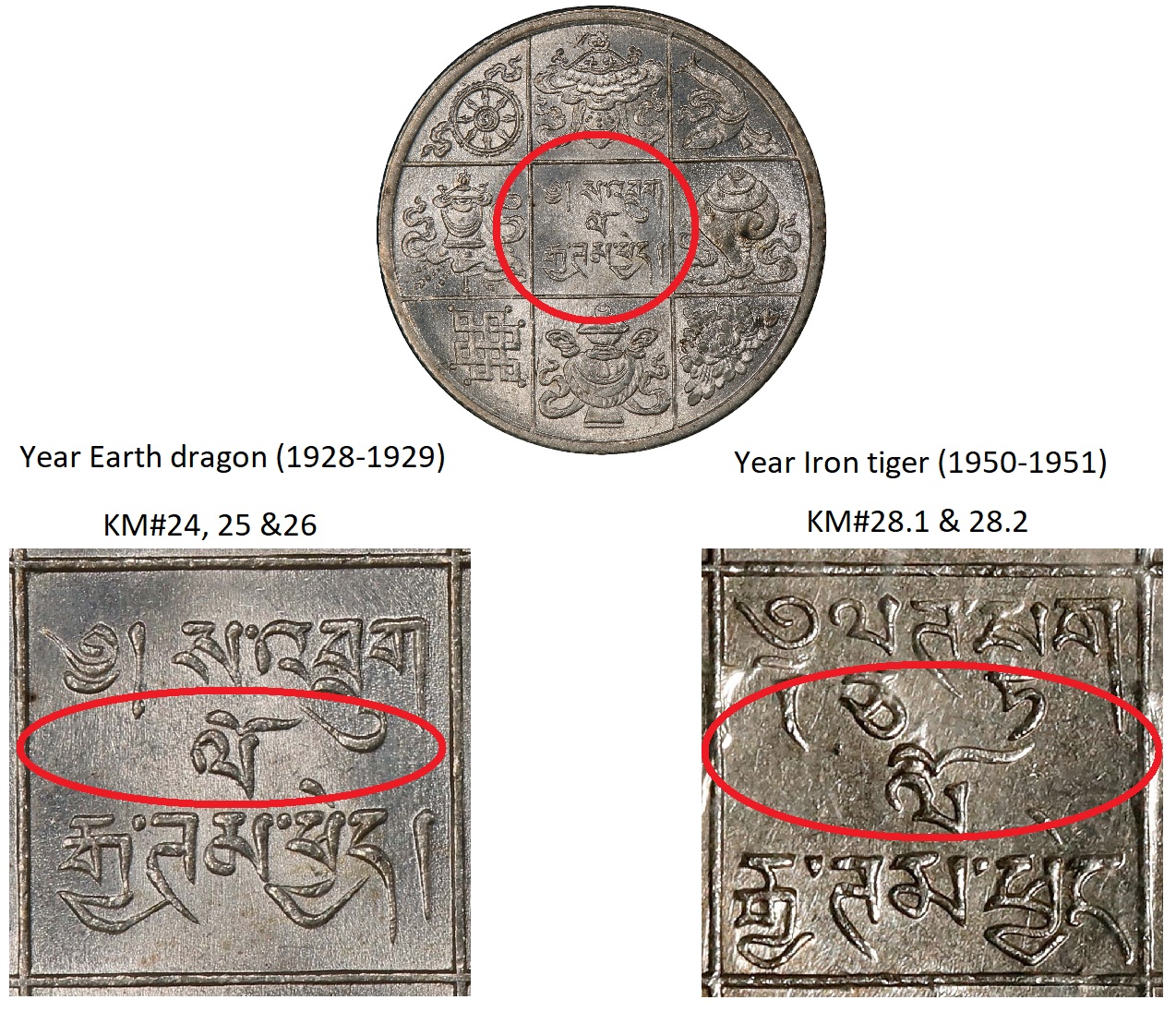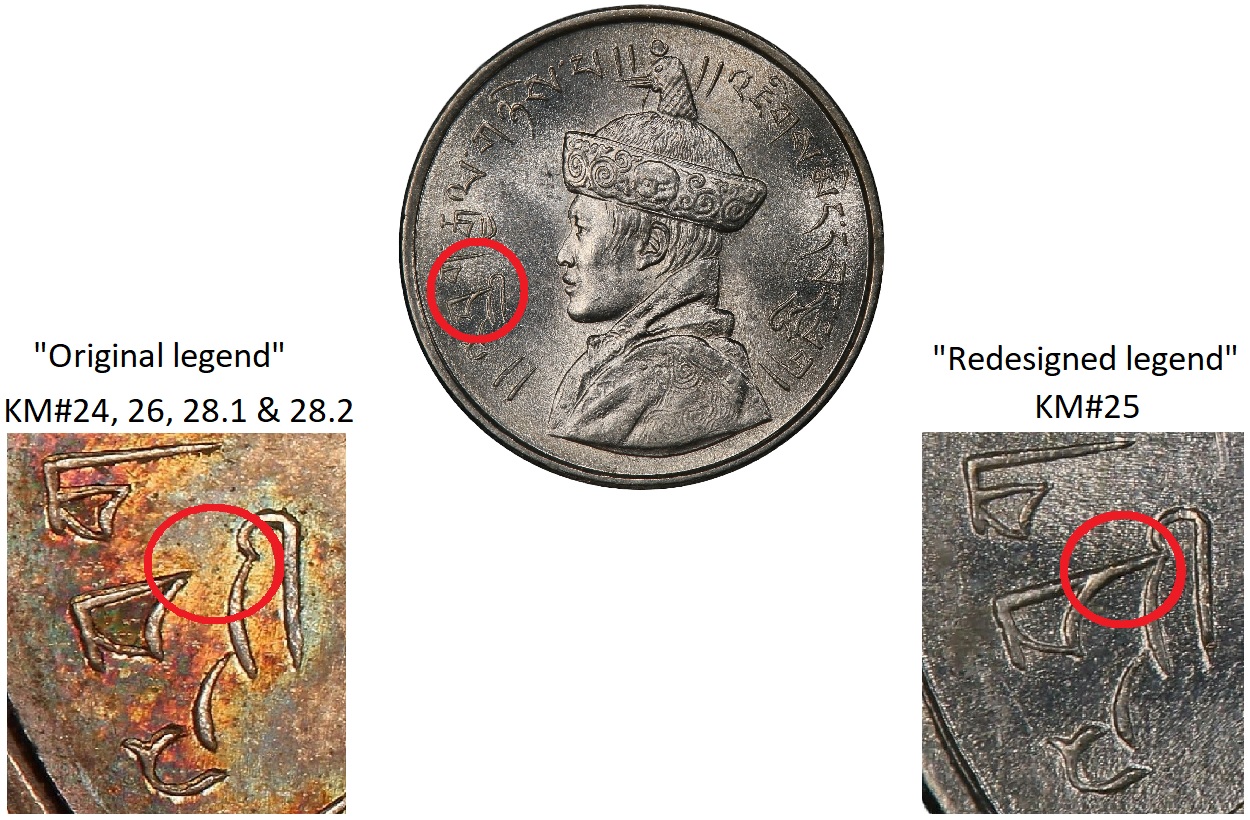½ Rupee - Jigme (Original legend: nickel)
Obverse

Crowned bust of king Jigme Wangchuck facing left.
Reverse

9 Sections, with the outer 8 cointaining the Eight Auspicious Signs (ashtamangala), and center with three-line legend. Symbols from top left going clockwise: 1) Wheel of Dharma. 2) Umbrella of sovereignty. 3) Golden fish of good fortune. 4) Conch shell. 5) Lotus. 6) Treasure vase. 7) Endless knot (Emblem of endless birth). 8) Victory bannern.
Basic Information
Category
Coin
Ruler
Jigme (Wikidata)
Technique
Milled
Orientation
medal
Demonetization
Yes
Face Value
½ Rupee (Numeric: 0.5) (Fraction: 1/2)
Engravers
Reverse
Albert Pearson Spencer
Physical Characteristics
Composition
Nickel
Weight
5.72 g
Size
24 mm
Shape
Round
Technical Details
Market Prices by Year
| Date | 5 |
|---|---|
| Mint | - |
| Mintage | 20,000 |
| G | - |
| VG | - |
| F | - |
| VF | - |
| XF | - |
| AU | 4.62EUR |
| UNC | 4.62EUR |
Comments
Regarding identificationBetween 1929-1968 four very similar types of ½ Rupee coins were struck by the Calcutta for Bhutan. It is not uncommon for these coins to be wrongly identified by grading services, auction houses and collectors, so checking for oneself is recommended when it comes to these coins. The four types are KM#24, 25, 26 & 28, and are differentiated by metal, year and the obverse legend. KM#28.1 & 28.2 are identical in appearance, and only differ in weight. For these types, there are two metals, silver and nickel. KM#24 & 25 are made of silver, and KM# 26 & 28 are made of nickel. The easiest way to differentiate them is with a magnet, as nickel is magnetic and silver is not. For the year, there are two types, both being from the Chinese cyclical calendar (Sexagenary cycle). KM# 24, 25 & 26 use the year earth dragon (23 January 1928-9 February 1929) and KM#28 use the year iron (also called metal) tiger (17 February 1950-5 February 1951). The year is found as a three line inscription in the center square on the reverse. Note that these years (with the potential exception of KM#24) does not match up when the actual coins were struck. KM#25 was struck in 1930, KM#26 in 1951, KM#28.1 in 1955 & KM#28.2 in 1967 & 1968. KM#24 was struck in 1929, and is so the only type which could have been struck in the same year as stated on the coin, but it is unknown when in the year it was struck. There are two types of obverse legend. KM#24, 26 & 28 use the original/first legend, and KM# 25 uses the redesigned/modified legend. They are almost the exact same, except for a small mistake featured in the original obverse dies, engraved in 1929, which was later fixed the next year. The mistake is that one of the letters misses a line connecting two parts. This correction was also featured on the 1931 bronze pice (KM#23) but for an unknown reason, the later nickel coins (KM# 26 & 28) featured the original mistake, but since that did not raise any objections, the error was not corrected. The error is also found on the 1966 series of coins commemorating the 40th anniversary of the accession of Jigme Wangchuk.
There are two types of obverse legend. KM#24, 26 & 28 use the original/first legend, and KM# 25 uses the redesigned/modified legend. They are almost the exact same, except for a small mistake featured in the original obverse dies, engraved in 1929, which was later fixed the next year. The mistake is that one of the letters misses a line connecting two parts. This correction was also featured on the 1931 bronze pice (KM#23) but for an unknown reason, the later nickel coins (KM# 26 & 28) featured the original mistake, but since that did not raise any objections, the error was not corrected. The error is also found on the 1966 series of coins commemorating the 40th anniversary of the accession of Jigme Wangchuk. Other information.According to Nicholas Rhodes in “Coinage in Bhutan ”a total of four dies were used for these coins. Two obverse dies (with and without the spelling mistake) and two reverse dies, one for each year. Albert Pearson Spencer, chief engraver at the Calcutta mint, made both obverse dies and the first reverse die (year earth dragon). It is unknown who made the second reverse die (year iron tiger). Spencer made the dies according to drawings supplied by the Bhutanese Government. Weight varies: 5.78-5.90 grams.
Other information.According to Nicholas Rhodes in “Coinage in Bhutan ”a total of four dies were used for these coins. Two obverse dies (with and without the spelling mistake) and two reverse dies, one for each year. Albert Pearson Spencer, chief engraver at the Calcutta mint, made both obverse dies and the first reverse die (year earth dragon). It is unknown who made the second reverse die (year iron tiger). Spencer made the dies according to drawings supplied by the Bhutanese Government. Weight varies: 5.78-5.90 grams.









